6 Content Marketing Strategy
Learning Objectives
In this chapter, you will learn:
- To understand the role of content marketing strategy within your marketing plan
- To be familiar with the steps involved in developing your content marketing strategy
- To recognise some models for understanding how types of content are absorbed or experienced by your target audience.
Introduction
While the phrase ‘content is king’ has been referenced for some time, it is only in the last decade that content marketing strategy has been solidified into a discipline of its own. Defining content marketing strategy can be tricky, however, with some practitioners focusing more on the role it plays in information architecture and others believing that it should be considered on a campaign by campaign basis.
This chapter looks at content marketing strategy from a holistic perspective, as a process that includes an understanding of all the content your brand is creating, those for whom it is intended and to what purpose. Content marketing is important for positioning your brand in the minds of consumers. As a content marketer, you need to understand the brand and consumer context and be able to craft appropriate content based on user receptiveness and channel-appropriateness. You also need to select the best route to customer in terms of tactics and to understand how content marketing fits and contributes to your overall marketing strategy. Ultimately this supports the design of communication that impacts people enough to make them want to share the content on.
Key terms and concepts
| TERM | DEFINITION |
|---|---|
| Algorithm | An algorithm is a mathematical, computational or statistical method pre-determined to take a number of variables into account and output a single, quantifiable result that is a function of all the variables. A good example of a commonly used algorithm is the one used by Google to determine which pages rank more highly on SERPs. |
| Content audit | An examination and evaluation of the existing content which a brand publishes. |
| Editor | A person who determines the ultimate content of copy, traditionally understood to be in the newspaper, magazine or publishing industry context. |
| Information architecture | The way data and content are organised, structured and labelled to support usability. |
| Persona | In this context, a character created to define a group of users in order to speak to them as though they were a unique user. Usually a hypothetical character created to represent and personify a set of traits. |
| Usability | A measure of how easy a system is to use. Sites with excellent usability fare far better than those that are difficult to use. |
Defining content marketing
Content marketing is an umbrella term which focuses on matching content (information, inspiration, or entertainment) to your customer needs at whichever stage they are in the buying cycle or customer journey. Unlike TV, where the advertiser pushes messages to a captive audience, the focus is on engaging content, which means that marketers must think like publishers (attracting an audience) rather than seeing themselves as advertisers (buying an audience) of a product. The Internet has, in many respects, cut out the middle man. Consumers and brands can now connect directly through a number of easily accessible online platforms.
The Content Marketing Institute offers the following definition:
Content marketing is a strategic marketing approach focused on creating and distributing valuable, relevant and consistent content to attract and retain a clearly- defined audience — and, ultimately, to drive profitable customer action.[1]
This definition applies to all the spaces in which you share content both traditional and digital. This includes printed magazines, booklets and promotional material as well as your social media space, website, campaigns, competitions and your company blog. The way in which that information is shared is also important.
Kristina Halvorson suggests the model illustrated below for approaching the different areas of content marketing strategy.
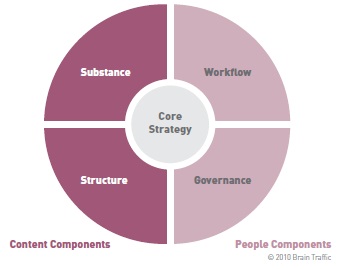
Content components
Substance: Who are you trying to reach and why?
Structure: Where is your content? How is it organised? How do people find your content?
People components
Workflow: How does your content happen?
Governance: Politics, guidelines and standards that your brand operates in[2].
As you can see in the above discussion, Halvorson suggests that one consider the bigger picture of content creation rather than just the product which is the end result. Content marketing looks at staff, tools, processes and outcomes. The end goal for these processes isconversion. All content should be created with a strategic outcome in mind. Such outcomes could include talkability, referral, affinity and ultimately purchase or increased usage of your product or service.
Strategic building blocks
Translating your brand essence
The brand essence sums up the unique attributes of a brand and the basis for its emotional connection with customers. Remember your emotional connection with your customer is the very things that differentiates your brand from your competitors. Your brand essence should assist in defining a tone of voice for your brand and the style in which it engages with its customers. The brand essence can be a useful guide for ensuring that the content you create (and your marketing activity) represents the brand appropriately. You can relate this to your brand story. What is your reason for being? How do you connect that with the interests of your customers? What is the value you add to your customers’ lives? Is it convenience, health, status?
Consider a brand like Mercedes Benz. Their essential product is transportation, but the brand offers so much more than that to its customers. For example, it provides a sense of safety and security, customers know they are driving a car with the latest safety technology. But the brand’s most powerful aspect is the sense of achievement and status that owning a Mercedes Benz provides. The value of the brand is less about the product itself and transporting passengers and more about the feeling and status the customer gets by owning the product.
Will It Blend? is a video series by Blendtec which builds on this principle. Blendtec produce industrial blenders. Their value proposition is that they can blend anything and their very popular videos demonstrate this.

Market research and consumer personas
The sweet spot for content marketing lies in an intercept between the marketing goals of a brand, the brand personality as it guides and differentiates that brand in the marketplace and the consumer motivation for paying any attention to a brand at all. One device that is used in addressing consumer needs is the development of a consumer persona.
A persona is a profile that a writer creates to embody the aggregated characteristics of the target audience for whom he or she is writing. It helps to personalise the brand. Personas are based on the profile of users of your content. Creating a profile is all about considering the characteristics of your customers and their needs and desires. For example, a brand like Philadelphia Cream Cheese could have a couple of customer personas. A busy father, who works full time, but still wants to provide healthy and nutritious lunches for his family. Or a young female foodie, who wants to try new recipes she finds online from international celebrity chefs to impress her friends at dinner parties. Each of these would require slightly different approaches when developing content. Both would benefit from videos featuring recipes, but one would appreciate regular basic options for lunchboxes and the other a celebrity endorsement or even a celebrity hosted video of finer and more elaborate meals.
It’s important to focus on the motivations of the persona that you may create, rather than exterior signifiers that lead to the creation of a stereotype. The persona assists you in segmenting and understanding your target market and is a framework through which you can guide any content that you create.
Creating Content Themes
Linked to the brand identity are certain themes or concepts. These are areas of focus that support the creation of content that match a consumer’s interest. These themes must be true to the brand essence, not focused directly on sales and should also speak to the interests of the audience.
CONTENT PLANNING APPROACH
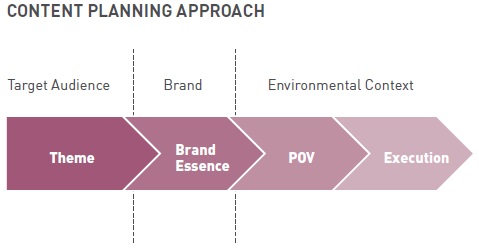
For Coca-Cola, for example, consumer interests filtered through the brand essence of ‘Coke brings joy’ could result in the following themes:
- Friendship
- Sharing is caring
- Spreading smiles.
These themes are then used as the basis on which to develop content ideas.
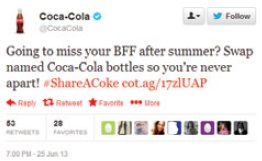
In the above tweet, we can see how a particular content theme was translated into a question that is focused on relationships and family. It also encourages engagement from the audience by asking for their input.
Another example which demonstrates this is how Corona brought their brand essence to life through an interactive documentary. The essence of the brand is to live the extraordinary and to provide amazing experiences to its customers. The documentary depicted a group of people from Bulin in China, officially the town furthest away from any ocean in the world, encountering the ocean for the very first time. A truly extraordinary and amazing experience, facilitated by Corona. You can view it here: www.youtube.com/watch?v=V8ELAv3Ovho.
Matching Content Formats to Objectives
Information can be presented through any number of mediums, which is both an
Consider the illustration below:
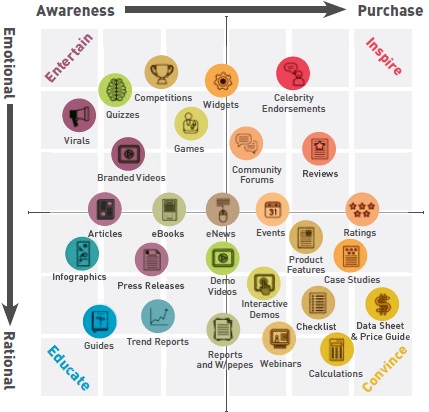
As discussed in the Strategy and context chapter, determining your objectives is an essential part of your marketing planning and should feed into your content marketing strategy and ultimately the business strategy. Understanding the journey your consumers go through as they approach your ultimate sales goal will enable you to match content formats to their needs. A humorous video may be successful in initially making potential customers aware of your brand. However, once you have their attention, a research paper or useful case study could be more effective in convincing them that you are the best choice in the market.
Price Waterhouse Cooper (PWC) is one of the largest international financial consulting firms, offering a range of financial services and advice across the globe. Every year they publish valuable content and guides to assist their customers with tax and wealth management. You can find the 2017 guide here: www.pwc.com/us/ en/private-company-services/publications/tax-wealth-management-guide.html
There are many examples of online journalism using multimedia to convey information most effectively to their users. The New York Times has presented a number of different methods for conveying complex information in an engaging manner. ‘Snow Fall’ by John Branch is one example: www.nytimes.com/ projects/2012/snow-fall/#/?part=tunnel-creek.

The New York Times also often publishes infographics that demonstrate this principle powerfully.
Because users consume content across multiple screens, multimedia is necessary to ensure you keep the audience engaged and they do not get bored with your content. See this infographic on the importance of exploring different types of multimedia with content marketing: blog.marketingv2.com/the-importance-of-multimedia- content-in-your-marketing-strategy.
To take advantage of these various forms of content delivery, it is necessary to build the correct capabilities. But how do you determine what forms of content you need?
The Content Audit
Once you have established your marketing goals, your brand personality and a guiding understanding of who you are trying to reach, the content audit is a necessary but sometimes laborious next step. The content audit involves an audit of all the existing content supplied by the brand such as the website, white papers, articles, videos and content shared on social media sites can all be considered.
An assessment can then be made of how well these pieces of content match the strategic needs of the brand, its audience and the appropriateness to the chosen channel.
While you can either thoroughly immerse yourself in this process or attempt to get a more time-efficient overview, the goal is to map what is currently on offer versus what is needed to achieve the strategic objective. It is important not just to understand what you have and who accesses it, but also how it is currently organised, through which channels and how often it is accessed by your audience.
Many practitioners suggest the use of a spreadsheet to achieve this. Content can be found to be either mismatched to the goals of the organisation, or spot on. Most importantly, you can establish what is missing. Are your customer needs being addressed? Where do the opportunities lie?
Content Creation
Learning From Publishers
Referring to a brand as publisher refers to expanding the function of the marketer or brand manager and opening up additional opportunities to influence and/or convert. Rather than focusing on the immediate sale or conversion, a publisher focuses on value and interest for the user and building a relationship based on supplying information, inspiration, or entertainment that suits the customer’s needs. Makeup. com by L’Oreal is an oft-cited example of a brand publishing useful tips and content that does not link to a product or sales directly, but demonstrates how the brand can facilitate the lifestyle consumers desire or aspire to. In content marketing a brand has to give customers more than just the product or service.
Resource Planning – Thinking Like a Publisher
Content marketing touches on a number of departments in an organization. Marketing, sales, customer service, corporate communications, human resources and website management teams should all be aware of the content marketing strategy for a business. Co-ordinating content between these teams can be challenging if not impossible if turnaround times are tight. This is why it is important not only to look at where content production should live in your organisation, but also to map the workflow of content creation, an essential function. Are designers involved? Where does quality control take place? Where can a piece of content be adapted and reused on a different distribution channel?
Some organisations opt to have a central role for someone to oversee content; others build in-house departments. Factors to consider are budget, creative control, approval and sign off processes, objective perspectives and full-time versus freelance resources. Whether you are outsourcing to a publishing house, or training a team in house, the decision must be made and planned for so that workflow can be mapped to facilitate your strategic needs.
Always on Content Planning
Given that a large part of the global population is constantly engaging with content via various digital devices and platforms, it is necessary to consider content creation in terms of not only short campaign bursts, but ongoing delivery and engagement. Consider the illustration below.
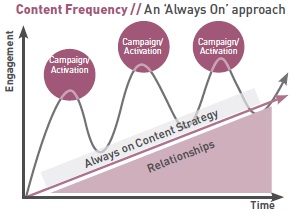
By constantly engaging with audiences, which is well suited to social media, for example, it is possible to build and maintain a relationship with customers/users. Consider the image above, where constant engagement is built by a constant presence and amplified by shorter-term campaigns.
Content models
Your organisation’s content requirements and objectives should determine the structure of your content teams. Do you have a need for ongoing content creation, or are there less frequent high-input forms of content that will benefit your organisation? There are many models which are constantly evolving, so invest in some research around what will suit your organisation. We have outlined two approaches below.
Stock and flow
Stock content refers to bigger, beautiful assets that require more investment and age well, meaning that they will be interesting in six months as well as today. ‘Inside Chanel’ by Chanel, is an example of this. High-production value documentary type videos are created and sponsored by the brand to achieve awareness and develop brand affinity across its target market. You can visit the Chanel channel on YouTube here:

Flow content has a lower production value and a quicker production and publishing time frame. Images depicting what is going on at a business on any given day, for example, freshly baked goods at a bakery, can be placed in this category. Weekly or even daily blogs as well as event and holiday themed content would all be considered flow.
Both types of content should be considered for balancing out a content strategy. It can also be useful to consider destination and distributed content. Content which you are either sending out to the world through various platforms and networks, or which pulls your user towards a page on your website or an article on your blog. Rather than focusing solely on driving users to your owned media spaces, such as your website, consider how to create content that engages with your target audience in the spaces and platforms they use online.
Content channel distribution
Algorithmic Curation
Algorithmic curation is a term that refers to the algorithms platforms have created for dealing with information overload. Various platforms, like Facebook,Twitter and the search engine Google, use algorithms to filter out the amount of information that is delivered to users. Each algorithm will use a number of factors to determine what is actually relevant and interesting to the user doing a search or looking at their news feed.
One of the factors that influences whether a piece of content is considered relevant is how much an individual engages with the brand’s presence on that platform over time. Posts shared by a Facebook Page, for example, may reach only users who have previously engaged with posts from that page through commenting or liking. It is therefore important to create content that encourages engagement and sharing.
Increasingly SEO and content marketing have to work together if they are to reach their audience and achieve their objectives. Without good content, SEO will struggle and without SEO even good content will not be seen. SEO approaches content differently to content marketing. SEO wants the content as narrow and focused as possible, so that they can give the right answer to the right user while users are searching. It also recognises the need for enjoyable shareable content as this improves search rankings and earns backlinks. Content marketers, on the other hand, prefer broader content and focus on the quality and exposing the content appropriately.[3]
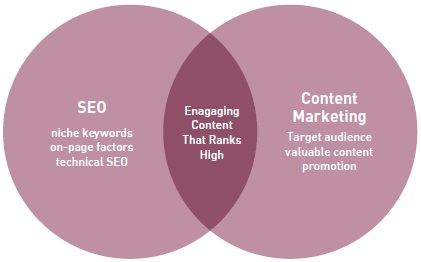
Understanding Channels and Platforms
Understanding the channels through which you share content is as important as the crafting of that content itself. Reaching people effectively will only be achieved if the medium supports the message and vice versa. Social media, email marketing, mobile marketing and video marketing are just some disciplines that will form part of your content creation arsenal. The rest of this book is dedicated to best practice in communicating effectively through the various digital disciplines available to you.
Tools of the Trade
In order to support the ongoing production of interesting content, it is necessary to have some planning documents in place. Consider those outlined below.
Brand Style Guides
This document guides anyone creating content for a brand at any time. What is the tone of voice and brand personality? How is it best represented visually and what are the brand colours and fonts? This can be a challenging document to put together and it usually isn’t the content marketer who is tasked with doing so, but is essential to aligning brand communications. It is also a document that tends to be ‘live’ as it is constantly updated as the brand and content landscapes evolve and new conventions need to come into play. Brand style guidelines are also referred to as Corporate Identity( CI) or Brand Identity (BI).
Content Calendars
Content calendars assist the content marketer in planning the content they will be sharing, across which platforms and when. The more advance planning is undertaken, the easier it is to react quickly to tactical opportunities.
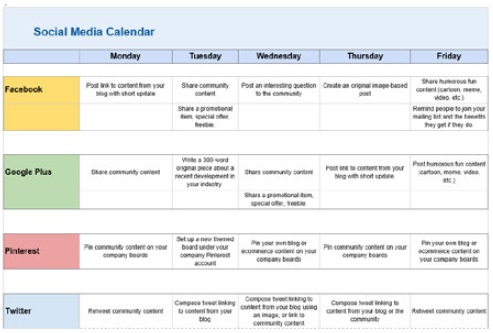
Workflow Map
A workflow map documents the path a piece of content takes when it is created. What are the steps in approval, how is it optimised for digital publishing, who has final sign off? Is it a duplicate of existing content and where else can it be used? A workflow map assists you in streamlining this process.

Persona Map
As discussed, the persona map assists content creators in focusing on those for whom they are in fact creating content and what the motivations of consumers may be.
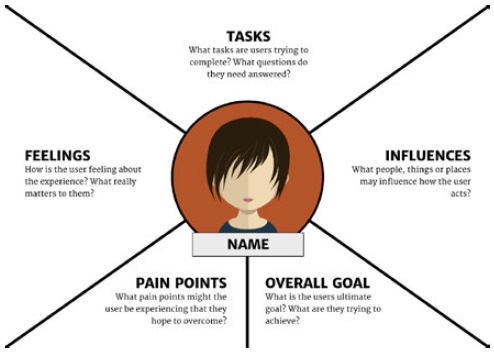
Advantages and Challenges
Content marketing can position your brand as an expert through the sharing of useful content in your specific field. It also enables you to reach the customer who has a fragmented attention span spread across many devices and content touchpoints.
One of the more powerful benefits, however, is that you can learn a lot about your target consumer through the content with which they do or do not engage. The more targeted and ongoing your content, the more data you can gather about how effectively you are reaching those you need to.
One of the great challenges in content marketing is providing content that is truly interesting and engaging to the right people with the right mix of subject matter and brand. Matching content to the required outcome for your strategic purposes takes dedication and focus. In the context of ongoing content production, it can also be a challenge to maintain levels of quality over time, which is why process and quality assurance steps must be put in place. Consider that the goal is not to create as much content as possible, rather it is to focus on relevance and content that matches strategic outcomes.
Case Study: Intel and Toshiba
One-line summary
Toshiba and Intel paired up to create an extremely successful social storytelling campaign that refreshed the ‘Intel inside’ slogan and boosted awareness of the new Ultrabook.
The problem
Intel and Toshiba both wanted to an opportunity to interact and raise awareness with younger consumers, aged 18–34 years old. They knew they didn’t want a regular ad, but something that would really engage the audience and get them to interact with the brands.
The solution
An interactive social film called ‘The Beauty inside’. The film starred real Hollywood stars and was a film about a character called Alex, who wakes up every day as a different person. On the inside he is the same, but on the outside, he looks like someone different. The story was about the fluid nature of identity and that despite outside appearances, it is what is inside that counts.
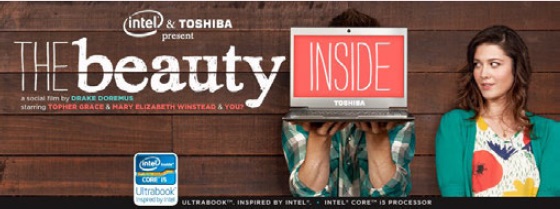
The campaign included a strong social element. Due to the changing nature of Alex, he could be played by anyone (male or female) and fans were invited to audition via the brand’s Facebook application for the role. Those chosen would star in the professionally filmed episodes with real Hollywood players. Additional audience created content was also shared in the Alex story on the Facebook page.
Watch this video about this incredible case study:
The outcome
Over 26 fans were cast in the film as Alex, chosen from over 4 000 contenders. And an additional 50 Alexes were featured on the ‘The Beauty Inside’s Facebook Timeline. The content resonated with the audience and the social nature of the film sparked engagement and shares.
- The results of the campaign were:
- 70 million video views
- 97% YouTube approval rating
- 26 million social interactions
- 40% lift in brand perception for Toshiba
- 66% lift in brand perception for Intel
- Increase in sales of 300% during the event, when compared to previous weeks.([4]
Despite being a few years old, this case study is a great example of how providing content with strong entertainment value to customers and engaging with them on an emotional and social level, can have dramatic results.
The bigger picture
Content is a significant component of many digital marketing disciplines. When creating content, you should always keep the principles of writing for the web in mind.
Email marketing relies on great content since most people suffer from email fatigue, they will only stop to read emails that they know are of high quality and that provide excellent content.
Social media marketing also depends on sharing relevant and valuable content with social fans. While your brand promise may get them to your social page, your ongoing stream of quality content will encourage them to interact and share, spreading the word about your company. If your content is great and really resonates with your audience, it could go viral.
Search engine optimization is strongly influenced by the quality, frequency and value of content. Not only will search engines favour your site, but others will choose to link in to your content, creating a valuable referrer for your brand.
Video marketing is a whole new approach to content, in which you create dynamic and shareable videos specifically tailored to the interests and needs of your audience.
Mobile marketing also requires that you consider the unique requirements of your audiences across a series of devices. If you understand the role that each device plays in a user’s life and buying cycle, you structure content according to user purpose and frame of mind.
Summary
Content marketing presents a pull mechanism for the marketer rather than a push one. It’s a gentler approach to traditional advertising and product or price promotions. Brands must consider their brand identity and the market they are trying to reach in order to create targeted and valuable brand content that delivers on strategic objectives.
It’s about more than creating a piece of content. Content marketing strategy looks at how you structure your organisation to create that content and how you match specific types of content and methods of delivery for achieving strategic outcomes.
These ideas need to resonate with people rather than simply existing across an array of media with which they are presented.
Case Study Questions
- What is brand storytelling?
- Why do you think Intel and Toshiba chose this option?
- What in particular do you think drove the dramatic lift in brand perception for both brands?
Chapter Questions
- What is content marketing strategy? How does it compare to business strategy?
- Why is the customer journey or buying cycle relevant to content marketing strategy?
- How do you decide what new forms of content your brand needs?
Further reading
contentstrategy.com – Content strategy for the web. contentmarketinginstitute.com/blog – the official blog of the Content Marketing Institute
the-cma.com – The Content marketing Association website. News, research and case studies on Content marketing.
This chapter is based on chapter 15 in eMarketing: The Essential Guide to Marketing Online.
References
Bosomworth., 2012. Content Matrix. [Online image] Available at: www.smartinsights.com/wp-content/uploads/2012/05/content-matrix-550×428.jpg [Accessed 30 January 2018]
Bowman, M., 2017. Video marketing the future of content marketing. [Online] Available at: www.forbes.com/sites/forbesagencycouncil/2017/02/03/video-marketing-the-future-of- content-marketing/#27eb8d106b53 [Accessed 1 November 2017]
Cognitive Media, n.d. Coca-Cola Content 2020 Part One. [Online] Available at: www.youtube.com/watch?feature=player_embedded&v=LerdMmWjU_E [Accessed 1 November 2017]
Content Marketing Institute, 2013. What is Content Marketing? [Online] Available at: contentmarketinginstitute.com/what-is-content-marketing [Accessed 1 November 2017]
Digital Training Academy, n.d. Content Marketing case study: How Intel and Toshiba got an audience of 70 million with social storytelling. [Online]
Available at: www.digitaltrainingacademy.com/casestudies/2015/03/content_marketing_case_study_how_ intel_and_toshiba_got_an_audience_of_70_million_with_social_storytelling.php[Accessed 1 November 2017]
Halvorson, K., 2010. Kristina Halvorson, Content Strategy on Conversation Agent. [Online] Available at: www.conversationagent.com/2010/12/kristina-halvorson-content-strategy.html [Accessed 1 November 2017]
Postan, L., 2016. Content Marketing and SEO. [Online] Available at: www.outbrain.com/blog/content-marketing-and-seo [Accessed 1 November2017]
Vipat, R., (2013) Digital marketing at Nike. [Online] Available at: www.slideshare.net/ojasvipat/final-digital-marketing-at-nike [Accessed 1 November 2017]
Figure acknowledgments
Figure 1. Adapted with permission, Kristina Halvorsen, 2010.
Figure 2. Screenshot, Blendtec, n.d.
Figure 3. Stokes, 2013.
Figure 4. Screenshot, Twitter 2013.
Figure 5. Adapted from, Bosomworth, 2012. Figure 6. Screenshot, New York Times, 2013. Figure 7. Stokes, 2013.
Figure 8. Screenshot, YouTube Inside Chanel, 2017.
Figure 9. Outbrain, 2017. www.outbrain.com/blog/content-marketing-and-se
Figure 10. Small Business Trends, n.d. smallbiztrends.com/social-media-calendar-template-business.
Figure 11. Own image.
Figure 12. UXPin, n.d. www.uxpin.com/studio/blog/the-practical-guide-to-empathy-maps-creating-a-10- minute-persona
Figure 13. Contently, 2016. contently.com/strategist/2016/01/06/the-new-hollywood-why-brands-are- making-movies

